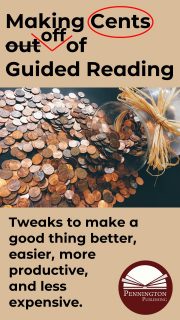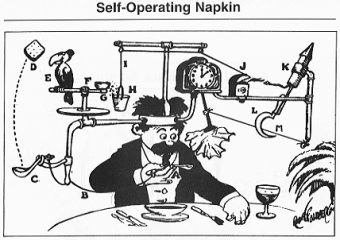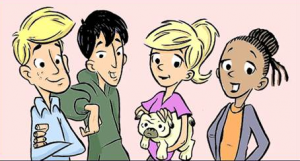Guided Reading and the Science of Reading
I’ve got to be careful on this topic. I’ve got family members who teach using guided reading, as well as plenty of colleagues, and their students are learning to read. Within the past 35 years, guided reading has become an educational given, accepted common sense, and an all-or-nothing teaching reading strategy. For Fountas & Pinnell and Teachers College, the guided reading method of teaching students with leveled books is a cash-cow. However, all-too-often educators assume and practice what has not yet been proven. Such is the case with guided reading.
Guided reading is based upon two theoretical premises: Vygotsky’s (1978) Zone of Proximal Development theory and Bruner’s (1986) application of that research to learning theory in what he termed as scaffolding. From these premises, Marie Clay, New Zealand’s godmother of guided reading, believed that students learn best in instructional level texts (Vygotsky’s Zone), guided by a teacher to independence (Bruner’s scaffolding), and then on to more and more challenging instructional texts in what she coined as the “ladder of progress.” Clay’s methods of determining independence (91–94%) is running records assessment.
Clay’s guided reading method sounds reasonable and practical. Simply put, it’s the Goldilocks principle: Don’t have students practice in books that are too hard (frustration level); don’t have students practice in books that are too easy (independent level). Instead, have students practice in books that are just right (instructional level) with teacher assistance.
Within the last 35 years, we have made enormous strides in determining readers’ levels of comprehension and matching them to levels of text complexity through Lexile testing or informed teacher judgment using running records. However, we have not yet proven that practicing at optimally determined reading levels produces more learning than reading text that is “too easy” or “too hard.” And we just don’t know if learning is best facilitated with Clay’s ladder of progress model. Is there such a thing as an optimal instructional reading level?
Dr. Timothy Shanahan argues, “Basically we have put way too much confidence in an unproven theory”(https://fordhaminstitute.org/national/commentary/leveled-reading-making-literacy-myth). He elaborates on the guided reading practice of using leveled texts to match optimal reading levels of instruction:
Of the studies that have directly tested the effects of teaching students to read with books at their “instructional level,” not one has found any benefit to the practice. There are several studies that have found no benefit to doing this and there are some that have found it to be harmful (that is, it reduces the students’ opportunity to learn). There is no set level at which texts need to be for students to learn from them, but if the texts are too easy (and traditional instructional level criteria are apparently too easy) learning is going to be limited. This has been found across a variety of grades from Grade 2 through high school and both with regular classroom students and learning-disabled students (https://www.shanahanonliteracy.com/blog/a-gallimaufry-of-literacy-questions-and-answers).
In fact, the authors of the Common Core State Standards would argue that students (with teacher assistance) learn more from complex i.e. frustration level text than instructional or independent text. My son read the entire Harry Potter series as a fourth-grader. While the first few books were add an accessible reading level, the last few certainly were not. My son gained two reading grade levels in a matter of months by reading text at his frustration level.
At this point, I know I’ve lost half of my readers. Teachers believe in the value of research only to a certain extent. When challenged by new or different research that is contradictory to accepted notions, teachers tend to retreat to their own experience. Generally, teachers believe in what they’ve been taught, how they were taught, and what they are now doing. Guided reading teachers see success in their students and the kids are learning to read. If it ain’t broke, don’t fix it.
However, for the remaining half of my readers: When they understand that the research does not prove what the majority of teachers are doing, they work through their cognitive dissonance and become more critical consumers of ideas and practice. They’re not afraid to distance themselves from the herd and try something new. A chance to add more tools to their tool belts.
My take is that we don’t have to throw the baby out with the bathwater. Some of guided reading makes complete sense: the structural and instructional components of flexible ability grouping, meaningful busy work for rest of kids, reading with the teacher on a daily basis, and authentic assessment are proven and effective instructional strategies; however a few tweaks are in order. We don’t and shouldn’t abandon guided reading entirely as some Science of Reading colleagues advocate. However, I would ask teachers to try a few adaptations.
My suggestions to make sense of guided reading:
- Rather than trying to fine tune your guided reading groups by adding more discrete reading level groups, think of combining groups to maximize instructional minutes, minimize independent work, and improve behavior management. Especially consider doubling the size of the teacher-led guided reading group and reducing the number of total groups. Check out these 10 group rotation schedules.
- Look to other means of assessment to determine reading needs and group placements, in addition to running records. Teachers don’t like to hear this, but we are not completely objective evaluators. According to Dr. Louisa Moats, “The reliability of oral reading tests and running records is lower than the reliability of more structured, specific measures of component reading skills. Teacher judgment of the cause of specific oral reading errors (e.g., miscue analysis) tends to be much less reliable” (https://www.aft.org/sites/default/files/reading_rocketscience_2004.pdf). (Download my FREE diagnostic assessments.)
- In addition to leveled reading groups, use this alternative assessment data to drive instruction within your guided reading group stations. Flexible groupings can help you teach r-controlled vowels to a group, or the soft /c/ spellings, or non-decodable sight words, etc. to needs-based groups, formed according to diagnostic assessments.
The benefits…
- Fewer groups means less prep for guided reading groups and other independent learning stations.
- Less wasted instruction. When teachers notice reading errors during guided reading or running records which they wish to address via mini-lessons, some, but not all students will benefit.
- Targeted needs-based instruction is more efficient than mini-lessons.
- Students will progress quicker with the addition of assessment-based instruction.
- Less $. Those Fountas & Pinnell A to Z leveled books are expensive. Why not purchase fewer levels?
- Less tracking. Traditional guided reading groups stay quite similar from the start to end of the school year, with notable exceptions.
- Better behavior management. With fewer groups, fewer transitions are necessary. With more students in the teacher’s group, less idle hands are making mischief.
- More teacher-student time.

The Science of Reading Intervention Program
The Science of Reading Intervention Program: Word Recognition includes explicit, scripted instruction and practice with the 5 Daily Google Slide Activities every reading intervention student needs: 1. Phonemic Awareness and Morphology 2. Blending, Segmenting, and Spelling 3. Sounds and Spellings (including handwriting) 4. Heart Words Practice 5. Sam and Friends Phonics Books (decodables). Plus, digital and printable sound wall cards and speech articulation songs. Print versions are available for all activities. First Half of the Year Program (55 minutes-per-day, 18 weeks)
The Science of Reading Intervention Program: Language Comprehension resources are designed for students who have completed the word recognition program or have demonstrated basic mastery of the alphabetic code and can read with some degree of fluency. The program features the 5 Weekly Language Comprehension Activities: 1. Background Knowledge Mentor Texts 2. Academic Language, Greek and Latin Morphology, Figures of Speech, Connotations, Multiple Meaning Words 3. Syntax in Reading 4. Reading Comprehension Strategies 5. Literacy Knowledge (Narrative and Expository). Second Half of the Year Program (30 minutes-per-day, 18 weeks)
The Science of Reading Intervention Program: Assessment-based Instruction provides diagnostically-based “second chance” instructional resources. The program includes 13 comprehensive assessments and matching instructional resources to fill in the yet-to-be-mastered gaps in phonemic awareness, alphabetic awareness, phonics, fluency (with YouTube modeled readings), Heart Words and Phonics Games, spelling patterns, grammar, usage, and mechanics, syllabication and morphology, executive function shills. Second Half of the Year Program (25 minutes-per-day, 18 weeks)
The Science of Reading Intervention Program BUNDLE includes all 3 program components for the comprehensive, state-of-the-art (and science) grades 4-adult full-year program. Scripted, easy-to-teach, no prep, no need for time-consuming (albeit valuable) LETRS training or O-G certification… Learn as you teach and get results NOW for your students. Print to speech with plenty of speech to print instructional components.
















